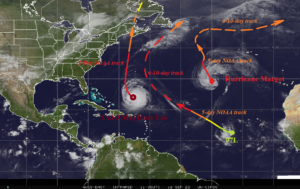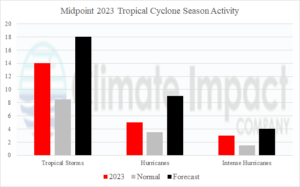97L Follows Lee and Margot, Potential East U.S. Problem
09/10/2023, 3:34 pm EDTWetter Central U.S. Ahead but Does That Rain Benefit Mississippi River?
09/13/2023, 9:06 am EDTHighlight: Lee will glance eastern New England Saturday.

Fig. 1: Satellite view of the North Atlantic basin.
Discussion: At 5AM EDT, Category-3 Major Hurricane Lee was located about 575 miles south of Bermuda with top wind 115 mph and central pressure 948 MB (Fig. 1). Lee is moving west-northwest at 7 mph. Lee is a large hurricane (Fig. 1) with an 80-mile-wide eye. Lee is moving slowly on the southwest side of the Bermuda High. An upper trough moving into the Northeast U.S. later this week will push the Bermuda High eastward and cause a southerly steering current which lifts Lee northward across cooler water. Lee will accelerate during the northward trek and weaken over cooler waters. Landfall is forecast over the western edge of Nova Scotia Saturday Night. Tropical storm conditions are likely on the east coast of New England Saturday and minimal hurricane conditions could affect coastal Maine and Nova Scotia late Saturday into early Sunday.
Margot is now a hurricane in the east-central North Atlantic tropics and forecast to drift northward this week eventually turning northeastward and accelerating toward U.K. in the 6-10-day period.
Tropical Disturbance 97L is likely to become a tropical storm within 2-3 days and possibly a hurricane in 5 days in the central tropical North Atlantic. The latest GFS and ECM operational models indicate this system will turn northward at 60W longitude rather than approach the East Coast as previously indicated.
In an update of the 2023 tropical cyclone season so far (Fig. 2), as of the midpoint, 14 named storms have occurred (8.5 normal), 5 hurricanes formed (3.5 normal), and 3 major hurricanes developed (1.5 normal). The ACE index is 86.4 (62.4 is normal). The average of all seasonal forecasts (18 tropical storms, 8 hurricanes, and 4 intense hurricanes) could be exceeded at the current rate of development.

Fig. 2: According to Colorado State University, seasonal tropical cyclone activity as of the midpoint of the 2023 tropical cyclone season in the North Atlantic, normal for this time of season, and a consensus of seasonal forecast activity.
